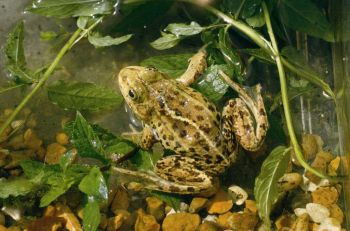Frog – Pool
Pool frogs (Pelophylax lessonae) were presumed extinct in the wild in 1995, but have since been reintroduced at a single site in East Anglia.
Identification
Pool frogs are extremely variable in colour, although the type reintroduced to the UK are predominantly brown with dark brown or black blotches over the back and a lighter, often yellow, dorsal stripe.
Adults can grow up to 9cm in length but males are significantly smaller. During the breeding season the males have a loud call generated by a pair of inflatable pouches (vocal sacs) each side of the mouth; a feature absent from the common frog Rana temporaria.
Lifecycle
Pool frogs breed much later in the year than the common frog. Breeding coincides with the onset of warm nights in May/June. The spawn ‘rafts’ are typically smaller than those of the common frog, and individual eggs are brown above and yellowish below. Pool frogs (and other members of the green frog ‘complex’) are known to bask in the sunshine on even the hottest days.
Protection
The pool frog has full protection under UK law. It is an offence to kill, injure, capture or disturb them, and to damage or destroy pool frog habitats. It is also illegal to sell or trade pool frogs. This law applies to all life-stages.

 Back
Back
